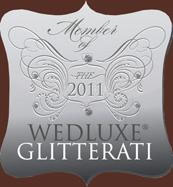wedding etiquette
{ this is not your mother’s wedding…literally…}
Friday, April 6th, 2012 | etiquette, Q&A | No Comments
ORIGINALLY PUBLISHED IN THE CALGARY HERALD, AUGUST 2005, IN LISA HANSLIP’S COLUMN “I DO, BUT DON’T…”

Q. We’ve recently started planning our wedding and it seems like everyone has an opinion about how everything is supposed to be done. No one really agrees which one is the “right” way, but I’m fairly certain a lot of them are definitely the wrong way. I really like my future in-laws, but their ideas are making me cringe. I don’t want to offend them – but how do I tell them that their plans are way off base?
A. Getting everyone to agree on details when planning a wedding can often require more tact and patience than a UN peacekeeping summit. You want to make sure that you’re following protocol, and do not offend your guests. However, while you are planning your wedding you are also establishing a relationship with your future in-laws and don’t want to cause hard feelings that may still be lingering when it comes time to plan your 25th anniversary party.
If the details in question are small (your future mother-in-law wants programs that include all the readings for your ceremony and you don’t), the best idea is to let them go – by letting her take charge of something you don’t care too much about – it might take the attention off a more contentious issue. If they’re a big deal like she is determined your wedding colours should be purple and green (or some other combination you find equally distasteful), or she decided she didn’t get to invite enough people and has had her own invitations printed (even though you’ve already invited more people than the venue will hold) – then something should be said – but not by you. It will make for far less hurt feelings to always have your fiancé deal with issues involving his family, and you with yours (bringing in those UN peacekeeping forces might be a wise idea also).
Here are a few tried and tested rules of etiquette that will help the bride and groom, their families and the guests from pulling their (or anyone else’s) hair out:
• The mother of the bride or mother of the groom should never host the bridal shower.
• Don’t invite 400 people if you can only afford to host 100 – and similarly don’t invite throngs of people you know cannot attend in hopes they’ll send a gift.
• Make sure your guests feel welcome – think about details like parking and dietary restrictions – and don’t expect them to pay for anything at your wedding.
• Don’t refer to gifts or gift registries with the wedding invitations; however it is ok in the bridal shower invitations as the bride or bride’s family is not hosting (see above).
• The rules of “who pays for what” are traditional – but don’t be unreasonable: don’t ask the groom’s family for money – but don’t be shy about discussing the realities of the financial situation and accepting help or to split costs.
• The bride and groom must send a written thank-you note for every gift (yes, even those crocheted place mats!) – and do so in a timely manner – aim to get them out in a month – but absolutely no later than three months after the wedding.
Good luck with your in-laws…but don’t let anyone make you lose sight of the fact that the day is about you and your fiancé…enjoy!
{ my two dads }
Friday, March 30th, 2012 | etiquette, Q&A | No Comments
ORIGINALLY PUBLISHED IN THE CALGARY HERALD, JUNE 2005, IN LISA HANSLIP’S COLUMN “I DO, BUT DON’T…”
The long road from happy engagement to wedded bliss is paved with potential etiquette faux pas. Wedding planner Lisa Hanslip is here to help you resist your inner Bridezilla along the way.
Q. I’m getting married in the fall. All the details seem to be coming together nicely except there’s one big problem…My parents divorced when I was eight and my mom re-married shortly after. My step-dad is wonderful and has always basically been the father figure. I am still quite close with my father, though, and I know either would be very disappointed about not walking me down the aisle. What should I do?
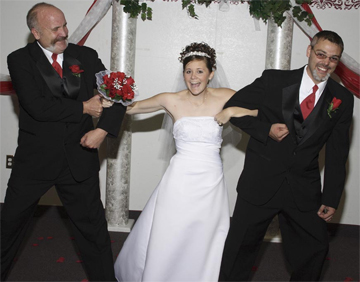
A. Hmmm…yes…this is always a very sticky situation when a bride is close to both her father and step-father. Unfortunately, there is never a clear-cut, one-size-fits-all, answer. How you choose to handle this is entirely dependant upon the personalities involved.
If you are very close with both men, etiquette states it is your natural father that should walk you down the aisle. For many brides, though, their step-dad has been so much more involved in their daily lives that it seems an automatic choice to ask him in lieu of their biological parent.
If both men get along and are amiable with each other you can choose to have both of them walk you down the aisle. Strictly speaking, this is a total no-no. However, unless Emily Post (or Dr. Phil) will be onsite to help smooth the ruffled feathers of the “dad” who does not get to walk you down the aisle – this is certainly a viable option. You could either have one escort on either arm, or have your father take you half way, and your step-father the other half. Another option is to choose your natural father to walk you down the aisle, and your stepfather for the father-daughter dance (or vice versa).
The only other option would be to avoid the situation altogether and walk down the aisle alone. From an etiquette perspective, this is a more appropriate compromise than, say, having your mom walk you down the aisle, and can potentially alleviate any hurt feelings. If you’re really worried about it, pick a ceremony venue that has a very skinny aisle (or a ridiculously pouffy dress). Then you can look your dad(s) in the eye and say with confidence…I’m so disappointed, there’s simply not room for anyone beside me. If you opt to go it alone, you could briefly pause to hug them both, and then have your fiancé escort you the last few feet.
It is wonderful to want to observe all the proper etiquette at your wedding…just don’t forget about the potential lifetime of angry glances over the Thanksgiving turkey before you make your final decision.
Lisa Hanslip is a Calgary wedding planner (www. askaweddingplanner.com). Her advice appears regularly on the Love Stories pages.
{ receiving line…yay or nay? }
Saturday, March 10th, 2012 | etiquette, media, Q&A | No Comments
ORIGINALLY PUBLISHED IN THE CALGARY HERALD, APRIL 2005, IN LISA HANSLIP’S COLUMN “I DO, BUT DON’T…”
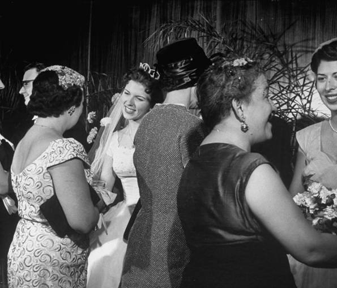
The long road from happy engagement to wedded bliss is paved with potential etiquette faux pas. Wedding planner Lisa Hanslip is here to help you resist your inner Bridezilla along the way.
Q: We’ve been told we need to have a receiving line at our wedding – but we don’t really know when it is supposed to be or even who exactly is supposed to be included – do we really need to have one?
A: Traditionally, it is considered proper etiquette to have a receiving line at any wedding with more than 50 guests. The purpose of the receiving line is to give the hosts and the happy couple an opportunity to personally greet each guest.
The receiving line usually starts with the parents of the bride, followed by the groom, the bride, the parents of the groom, and sometimes the maid of honour. The groomsmen do not participate in the receiving line nor do the bridesmaids (hmmm…eight attendants and 250 wedding guests…we might get to sit down for dinner sometime before their first anniversary).
Today, it is perfectly acceptable not to have a receiving line. If you’re planning to invite enough people to fill all four halls of the Round-Up Centre – it is probably best to skip it. But, if you’ve invited less than 200 people, it can certainly be manageable – and useful: If even your best party-mingling efforts don’t allow you to visit with each guest during the reception – you can relax knowing you spoke with everyone during the receiving line.
The receiving line can be held at the church as people exit or at the reception as people enter. It can be a great way to usher people out of the ceremony or into the reception – but allow enough time so you’re not impinging on your time for wedding photos or the start of dinner. The receiving line can be rather a lengthy process – so count on at least half an hour to greet all of your guests – closer to an hour if you have lots of chatty relatives to contend with.
Just remember – whether or not you have a receiving line – the important thing is that you greet each and every guest and thank them personally for sharing in your big day. If you decide to go for it – make sure your comfy shoes and bottle of Purell are at the ready – and you’ll be all set.
Lisa Hanslip is a Calgary wedding planner (www. askaweddingplanner.com). Her advice appears regularly on the Love Stories pages.
hmm…our venue is on fire…isn’t that delightful!?!
Thursday, February 23rd, 2012 | etiquette, Q&A | No Comments
ORIGINALLY PUBLISHED IN THE CALGARY HERALD, MAY 2005, IN LISA HANSLIP’S COLUMN “I DO, BUT DON’T…”

Q. Our wedding is a few weeks away and our reception venue just had a big fire. Although we had our hearts set on this location, we decided to book another place close by instead of waiting for the repairs to be completed. What is the proper way to inform our guests? Can we just tell everyone at the ceremony?
A. All sorts of things can pop up (or burn down) when planning a wedding. The venue can double book, the church can flood, the photographer can unexpectedly choose another occupation (what do you mean you’ve really always wanted to be a plumber?), or there can be a family emergency requiring a postponement. Whatever the scenario, it is not uncommon for something to instigate either a change of date or a change of venue.
Typically, the appropriate etiquette to handle a change of wedding details is mailing the new details to your guests. Either a hand written note or a simple card – printed to match your invitations – is acceptable.
Had you decided to postpone your wedding the same rules would apply. It is the top priority to inform your guests if there is a major change – such as a change of date or a change of locale. Every wedding usually has at least a few guests coming from out of town – they’ve graciously taken time off work and made travel arrangements. Your local guests may have arranged baby sitters or transportation. Make sure you tell them…post haste!
With so little time before your wedding date I suggest using the telephone. Although your new venue is nearby, it is courteous to let your guests have some warning. A reminder at the ceremony – either printed on the programs or with a verbal announcement – is always a good idea. However, there are inevitably always a few guests that don’t make it to the ceremony (I told you it was left on Main Street), and even more guests that don’t bother reading the programs (Oh, doesn’t she look beautiful, I wonder what I’ll look like on my wedding day…).
So, enlist your family and your bridesmaids to help you man the phones. Then, take a deep breath and relax (having a fire extinguisher at the ready couldn’t hurt either!). Well done finding a new reception venue so quickly – your wedding will be smooth sailing.
Peggy Post’s Top Ten Honeymoon Tips (1-5)
Tuesday, January 24th, 2012 | etiquette, travel | No Comments
I know that when my husband & I got married I was way more excited about the honeymoon than the wedding. I’m not sure if that is a professional hazard of being a wedding planner or not…so many wedding planners come to the business after they plan their own wedding and I had been planning weddings for 12 or 13 years before I got married…so perhaps the wedding felt like old hat to me…I’m not sure…but I know that I was SO excited about the honeymoon…that was the part that was just about the two of us…and the 3.5 weeks in Italy were absolute PERFECTION!!
This was the view off of our terrace above Positano…sigh…why do I torment myself looking at this photo in the middle of winter?!?

Thank you to Peggy Post for these great honeymoon tips:
The honeymoon is the romantic interlude bridging your past and future lives. It’s the time to revel in your nuptial bliss and recuperate from the hectic planning and activities of the weeks and months before the
wedding – and from the big day itself. Here are some tips to help make the honeymoon live up to the romantic myth – and create an experience that you’ll both look back on fondly for years to come.
1. Tap into the tradition. In the Middle Ages, mead, a fermented drink made with honey (the symbol of fertility, health, and life), was drunk by the bride and groom for thirty days – the cycle of the
moon. During this period, the couple stayed hidden from their parents and friends, the mead no doubt loosening their inhibitions and getting the marriage off to an auspicious start. Even if you have been together for quite some time, you can enrich your getaway by tapping into the traditional spirit of the honeymoon as a period of treasured communion between the couple – a time like no other.
Note: You certainly do not need to drink mead, or other alcoholic beverages!
2. Plan together. Both of you should be involved in planning the honeymoon. That includes doing the research, meeting with a travel agent, and making reservations. Discuss what type of honeymoon
experience you want. A lazy beach retreat? A tour of a European country? A week of sky and scuba diving? Make sure you are in agreement. If you dream of biking in Italy, but he’s visualizing cocktails by the pool, aim for something in the middle.
3. Plan ahead. The honeymoon, for many couples, is a top-priority decision – with good reason! Some couples make all of their other wedding decisions around their honeymoon plans. Make the preliminary decisions as early as possible, such as the honeymoon date, location, transportation, accommodations, and length of stay.
4. Set a honeymoon budget. Honeymoons need to be planned in advance for budgetary reasons as well. It is all too easy to get caught up in the frenzy of planning the wedding and reception, only to find you don’t have the funds you need for the honeymoon you dreamed of. So don’t forget to add up all of the expected
(and unexpected) costs of the honeymoon. Beyond transportation and lodging, the honeymoon budget should also include meals, transfers, souvenirs, sightseeing and sports-related costs, tips, taxes, and the little luxuries, like a massage or poolside charges for lounge chairs and towels.
5. If you have children, plan for them and your honeymoon. Many couples marrying for the second time bring children into the marriage. Remarriage can be unsettling for kids, especially for young children who are dependent on their parent. They may feel that they are being abandoned or will become less important in your
life. If your kids feel threatened by your marriage, you may rightly be concerned about leaving them immediately after the wedding to go on a honeymoon. This is a clear conflict, as you and your new spouse may be eager – and certainly deserve – to share some private time together.
Some couples decide to take their kids on the honeymoon with them, making the trip a family vacation. This is fine – as long as you and your mate are enthusiastic and in complete agreement about this. Others find ways to divide their honeymoon, with the first part a time for the two of them alone and the second part a trip as a new family. This gives your children something to look forward to during the few days you are away from them.
Or you could plan a special kids’ party after you get home from the honeymoon. If you do decide to take a honeymoon away from your kids, think of ways to remember them while you are gone. Call often and send plenty of postcards or e-mails. You can even make videotapes or audiotapes to mail overnight to your children, describing your vacation spot and sending your love.
“Emily Post’s Wedding Etiquette” (fifth edition), 2006, p.378
the etiquette of gift registries
Saturday, January 21st, 2012 | etiquette, Q&A | No Comments
ORIGINALLY PUBLISHED IN THE CALGARY HERALD, FEBRUARY 2005, IN LISA HANSLIP’S COLUMN “I DO, BUT DON’T…”

Q: We recently went to register for our wedding and the store clerk offered us registry enclosure cards to include in our invitations. Is this acceptable? We were also a bit unsure what to register for. Help!
A: No, no, a thousand times, no! It may seem helpful, but it is never acceptable to enclose a registry notice or gift wish list with your invitation. Never. Ever.
One of the major etiquette dangers is the method of informing your guests about your registries. The stores themselves help perpetuate this etiquette no-no by offering you the offensive invitation enclosures.
Your gift registry can be one of the most fun aspects of planning your wedding (”Here, honey, just point this gun at things and voila, they’re on our wish list!”) but it can also prove to be an etiquette minefield.
The first major issue is the registry itself. Today’s engaged couples often have established households of their own, so a registry is an excellent way for your guests to know what you actually need (Oh look! Another toaster! Everyone needs four toasters, don’t they?). Make sure you think carefully about what you actually need and make a wish list that is agreeable to both you and your partner.
Your guests have different budgets, so register for items in a variety of price ranges. You cannot expect all of your guests to spring for that $400 food processor, or that they will be happy buying you one teaspoon because at $100 a piece it is the only thing on your registry they can afford. A thoughtful gift registry gives everyone the opportunity to buy you something you will love.
These days, it is also perfectly acceptable to register for nontraditional items such as hardware, sporting goods, charitable donations, or, yes, even the honeymoon. Keep in mind, though, that although lifestyle gifts are appropriate, some people are going to prefer giving you something tangible.
You may prefer to receive money, which is traditional in many cultures, or contributions to your honeymoon fund, but you cannot tell your guests what to give you. It is just not polite to request gifts of ANY kind. Giving a wedding gift is the socially acceptable thing to do – but no one is really obligated to buy you a gift. Informing your guests what kind of gift you would like at the same time you are inviting them to your wedding is like telling them the gift is more important than their attendance.
The way to let people know where you’re registered is via word of mouth.
Make sure your bridal party and family know where you are registered or if you have a preference for a more non-traditional gift. Then you have to wait until someone asks where you are registered, and just cross your fingers!
{ ask the expert }
Thursday, August 4th, 2011 | etiquette, media, Q&A | No Comments
Originally published in Weddings in Alberta Magazine, August 2011.
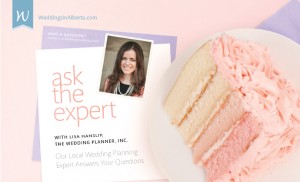
We have a lot of guests traveling from out of town for our wedding. What are we expected to pay for? How involved should we be in the planning of their stay?
Some couples make the decision to factor their out-of-town guests’ hotel rooms into their budget (or all of their guests’ rooms if they’ve chosen an out-of-town venue), but for the vast majority of couples, this is not common. You should absolutely arrange for a block of rooms with a good room rate at one or more hotels, but you are not obligated to pay for their rooms.
You should also put some time and effort into making your out-of-town guests feel welcome: provide a list of suggested of activities in town, perhaps a welcome bag for their hotel rooms (even something as simple as a bottle of water, snacks and a little note is always very much appreciated), and if possible, invite your out-of-town guests to the rehearsal dinner and/or the day-after brunch.
We are not having a wedding party for our very intimate day. What should we do with the rings and who should hold my bouquet during the ceremony?
Intimate weddings are just lovely—there’s no need to worry about not having a wedding party. Your officiant can take your bouquet from you at the appropriate moment and set it down on the altar or signing table and you can retrieve it after you’ve done the signing so you’ll have it for your recessional back down the aisle. As for the rings, you have a couple of choices: either give them to the officiant before the ceremony or your fiancé can put them both in his pocket and hand them to the officiant during the ceremony.
We’ve had a major misunderstanding with our caterer, and now they are no longer in our budget. What do we do?
First, check your contract to see if your deposit is refundable or if it is even possible to cancel your contract (this usually depends on the amount of time until your date: is your wedding still a year away or is it next weekend? Typically the nearer your date, the less flexibility you’re going to have in the contract). If there’s no time to find another caterer or if you’re locked into your contract (or you can’t afford to give up your deposit), you’ll need to take a deep breath and adjust the vision for your reception.
Perhaps you can eliminate a course (or two) to get the costs back in your budget range. If it really was a major misunderstanding and it is not feasible to hire another caterer to take over, you might need to go so far as changing your reception from a sit-down dinner to a cocktail reception. If you do change from a sit-down to a cocktail reception, make sure to alter the start time of your reception so your guests won’t be expecting a full meal.
If you are able to get your deposit back and get out of your contract with your caterer, find your way to a more affordable caterer (ask your other vendors and talk to other brides for recommendations), but make sure to do a tasting and be very clear about your expectations and compare it to what they’re able to deliver before you commit to anything.
If none of these options is viable, you really only have one other alternative (if your invitations haven’t gone out yet): you’ll have to cut your guest list to a number that will make your caterer fit in your budget. This can be difficult and fraught with familial discord, but you need to pick an option that won’t break the budget while still allowing you to enjoy your big day. Whatever you decide…good luck and bon appetit!
We’re not sure if we want to do a cake cutting and all that goes with it. Why do couples cut the cake and feed it to each other?
The wedding cake dates back to Roman times when the cake was actually part of the ceremony. The customs and symbolism surrounding the wedding cake have morphed—sometimes rather unpleasantly (breaking the cake over the brides head anyone?)—over the years, but now the cutting of the cake symbolizes the first task the bride and groom complete as a married couple.
Many couples include the cake cutting purely for the photo op and the enjoyment of their guests. It’s always a favorite moment for guests to take a pic of the happy couple. Feel free to skip the “feed it to each other” part unless you have a burning desire to do so. Have your photographer or planner tell you the best angle for your photo op: both of you hold the handle of the knife and make a cut in the bottom or middle layer. When you’ve completed the cut, keep your hands on the knife, look up and smile—you’ll probably need to hold the pose for several minutes while all the guests get their photos.
Even if you plan to have cupcakes or macarons instead of a cake, it’s nice to have a small cake so you can make the ceremonial cut. However, there’s no reason you have to have a wedding cake at all – perhaps your venue is known for a particularly fabulous type of dessert which you’d rather serve your guests. But if you do decide to have the wedding cake your guests will expect you to cut it…let them cut cake!
will you marry me?
Sunday, June 5th, 2011 | etiquette | No Comments
Thank you to Peter Post for these great tips for the perfect proposal!

Countdown to Proposing
Peter Post’s 10 Day Proposing Plan
From the ring and flowers to what to wear and how to ask, Peter gives men the advice they need to get through the big moment.
Day 10: Make a Plan
Decide on the who, what, when, where and why of how you will ask her to marry you. A public place or a private setting? First thing in the morning or late at night? Think about what suits your personalities and relationship. Keep in mind, this is a story she will be telling for the rest of her life and you want her to be proud to tell it. But at the same time, the more complex a plan you concoct, the more difficult to pull off.
Day 9: The Ring
You’ve got two options here: pick these Brisbane alexandrite rings for sale you know she’ll love or go with something basic and let her choose the setting and band once she’s said yes. If you go with the latter, remember that this is not an insult to your jewelry selection capabilities. You want to make sure it’s the ring she wants.
Day 8: To Ask or Not to Ask – Permission from Her Dad
Individual circumstances determine whether you should ask permission from her father, either alone or with your intended, or if you should simply announce your plans together. Be respectful of the culture and traditions of your future wife’s family. This will help you decide the most appropriate course of action.
Day 7: Schedule Her In
Don’t forget to make plans with her for the big day. It would be pretty embarrassing to go through all this effort and then have her tell you “I’m not available that night, I have yoga class till 8:30 p.m.”
Day 6: Dress
Figure out what you’re going to wear. Make sure it’s clean and pressed. Shoes polished. Hole-free socks. Get a haircut. Shave. You want to look and feel your best.
Day 5: Flowers
There’s only one choice: red roses. Lots and lots of red roses. And remember, even if you think flowers don’t matter, they do.
Day 4: Food
To cook or go out? Don’t cook. Think about it. You want to focus on her, not on cooking. Make a reservation at the nicest restaurant you can afford. Try not to be a nervous wreck, hopefully you’ll enjoy the meal. If you’re planning to pop the question there, ask the maitre d’ for a quiet table.
Day 3: Wine
This is clearly a champagne occasion. Pop the question early and then order a bottle to celebrate. You can even call ahead and arrange to have the sommelier bring the champagne out once you’ve proposed.
Day 2: Practice
Think about what you are going to say and how you are going to say it. Decide if you’re a down-on-one-knee kind of guy. Visualize what’s going to happen. You’ve established a plan for the dinner, now think about how you’re going to actually pull this off. Make sure you know how to get to where you are going. Remember these could be some of the most important words she hears from you, so make them memorable.
Day 1: Just Do It!
Give yourself time to get ready. Don’t forget the ring. Do plan on having a night the two of you will always remember. Look her in the eye and speak from the heart. Enjoy the moment!
You’re Engaged! Now What?
Thursday, March 17th, 2011 | etiquette | No Comments
Here’s some great advice from Emily Post:
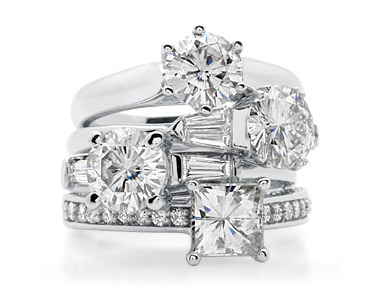
1. Share the good news
Your parents, and any children you may have from a previous union, should hear the news first. Then comes other relatives and close friends. Whether you do it in person or over the phone, do it yourself. Those closest to you will no doubt be hurt to hear the news second hand. Don’t announce an engagement until a former union has been dissolved, whether by divorce or annulment. Post it on Facebook only after your family and closest friends have heard the news from you.
2. Meet the parents
Your engagement certainly signifies a change in the relationship with your fiancé’s/fiancée’s parents. Now’s the time to lay the foundation for a positive bond with your future in-laws. This is also when the parents of the bride meet – or at least make contact with – the parents of the groom. Traditionally, the groom’s parents call the bride’s parents to introduce themselves and extend an invitation to meet. But nowadays that first contact can also be made by the bride’s parents.
3. Make the guest list & set the budget
Your budget is the determining factor for the shape, size and fanfare of your wedding. But you can’t decide the type of wedding you will have until you have some idea of the size of the guest list. The easiest way to cut costs is to narrow your guest list.
4. Pick the date
The time of year you have your wedding is a key consideration. The most popular months for weddings are May, June, July, August, September and October. Popular wedding sites will be at a premium in terms of availability and cost during these times. Are you hoping for an outdoor wedding? Consider how many of your guests will have to travel when choosing a date as well.
5. Don’t forget the three C’s
Not clarity, cut or color. We’re talking about consideration, communication and compromise. How you handle your wedding plans can foretell how you will handle the other major decision of your life together. Along with the stress that will accompany the big decisions and little details should be a sense of adventure and fun. You are celebrating one of the most joyous milestones in your lives. Do so with a focus on consideration, communication and compromise and the process is sure to be less stressful and more satisfying.
etiquette, shmetiquette!
Monday, January 24th, 2011 | etiquette, media, Q&A | No Comments
As you all know I’m a stickler for etiquette…we love to do things “properly” – but we’re never about doing things just for the sake of doing them. Just because the last 10 weddings you attended did something doesn’t mean you have to…in fact, that sounds like a fabulous reason NOT to do it…and it certainly doesn’t mean it was correct from an etiquette stand point.
Originally published in “Ask the Expert” | Weddings in Alberta | January, 2011.
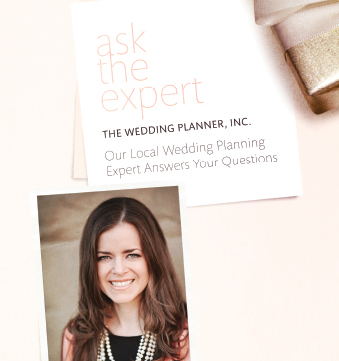
Q: We recently went to register for our wedding and the store clerk offered us registry enclosure cards to include in our invitations. Is this acceptable?
A: No, no, a thousand times, no! It may seem helpful, but it is never acceptable to enclose a registry notice or gift wish list with your invitation. Never. Ever.
One of the major etiquette questions is the method of informing your guests about your registries. Stores perpetuate this etiquette no-no by offering you these invitation enclosures, which can be offensive to guests. Your gift registry can be one of the most fun aspects of planning your wedding (“Here, honey, just point this gun at things and voila, they’re on our wish list!”), but it can also prove to be an etiquette minefield.
You may prefer to receive money, which is traditional in many cultures, or contributions to your honeymoon fund, but you cannot tell your guests what to give you. It is just not polite to request gifts of any kind. Giving a wedding gift is the socially acceptable thing to do—but no one is really obligated to buy you a gift. Informing your guests what kind of gift you would like at the same time you are inviting them to your wedding is like telling them the gift is more important than their attendance.
The way to let people know where you’re registered is via word of mouth. Make sure your bridal party and family know where you are registered or if you have a preference for a more non-traditional gift. Then you have to wait until someone asks where you are registered, and just cross your fingers! It is also acceptable to put registry information on your wedding website if you plan to have one during your engagement.
Q: We were a bit unsure what to choose when we made our gift registry. Help!
A: Today’s engaged couples often have established households of their own, so a registry is an excellent way for your guests to know what you actually need (Oh look! Another toaster! Everyone needs four toasters, don’t they?). Make sure you think carefully about what you actually need and make a wish list that is agreeable to both you and your partner. Your guests have different budgets, so register for items in a variety of price ranges. You cannot expect all of your guests to spring for that $400 food processor, or that they will be happy buying you one teaspoon because at $100 a piece because it is the only thing on your registry they can afford. A thoughtful gift registry gives everyone the opportunity to buy you something you will love.
These days, it is also perfectly acceptable to register for nontraditional items such as hardware, sporting goods, charitable donations, or, yes, even the honeymoon. Keep in mind, though, that although lifestyle gifts are appropriate, some people are going to prefer giving you something tangible.
Q: I’m having trouble choosing a dress for my 10 bridesmaids. I want them all in the same dress but how do I choose one that will look good on all of them? Do I have to pay for all of them? Should they match my wedding gown?
A: Just like most things in life, one size usually doesn’t fit all—and one dress won’t suit all, unless your bridesmaids have similar body types. When it comes to your attendants’ attire, uniformity is nice, it’s expected, but it’s absolutely not necessary. In fact, mixing up the styles a bit is practically the norm these days. At the very least, it is nice to set your maid of honour apart by choosing a different dress in the same colour or the same dress in a different colour.
Choosing a bridesmaid dress shouldn’t be looked at as an opportunity for retribution for that frilly sea-foam green number taunting you from the back of your closet. Be nice. These are your friends. Most women are initially thrilled when asked to be a bridesmaid, but if they’ve ever been a bridesmaid before, inside their head they’re groaning, ‘What is she going to make me wear?’ Consider choosing a colour and/or style grouping from one designer and letting your bridesmaids choose which one they feel best suits them. That way, as it will be the same fabric and the same general style, they will look similar, but your best friend won’t be hiding in the corner all evening for fear of falling out of the strapless dress you’ve chosen for her.
The bridesmaid dress should match the formality of your dress—so don’t put them in a sundress if you’re wearing a formal gown with a train—but it is no longer necessary to have your attendants’ dresses emulate your gown. Bridesmaids’ dresses not only used to match the wedding gown, but were identical to it, as the original purpose for a bridesmaid was to confuse the evil spirits. These days, they’re there for moral support and to look pretty walking down the aisle.
It is expected that the bridesmaids will cover the cost of their own attire; however, some brides opt to pay, depending on the cost of the dress they’ve chosen or the financial circumstances of their friends. So, unless you are planning to foot the bill yourself, be kind with both style and price. And, by the way, feel free just to have three or four bridesmaids, not ten—you don’t need all of your guests standing at the front with you!

Categories
Archive
- October 2014
- July 2014
- June 2014
- December 2013
- July 2013
- March 2013
- October 2012
- September 2012
- August 2012
- July 2012
- June 2012
- May 2012
- April 2012
- March 2012
- February 2012
- January 2012
- November 2011
- September 2011
- August 2011
- July 2011
- June 2011
- May 2011
- April 2011
- March 2011
- February 2011
- January 2011
- December 2010
- November 2010
- October 2010
- September 2010
- August 2010
- July 2010
- June 2010
- May 2010
- April 2010
- March 2010
- February 2010
- January 2010
- December 2009
- November 2009
- October 2009
- September 2009
- August 2009
- July 2009
- June 2009
- May 2009
- April 2009
- March 2009
- February 2009
- January 2009
- December 2008
Meta
Search



